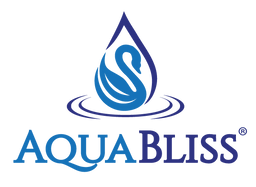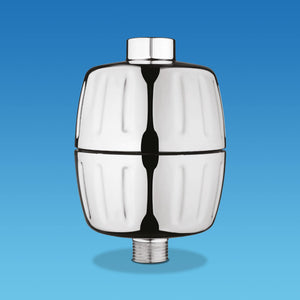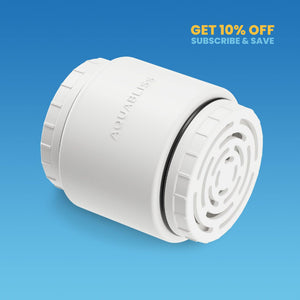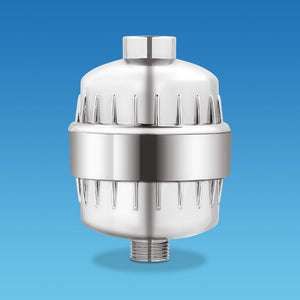Hard water leaves calcium‑ and magnesium‑rich residue that shows up as chalky water stains on shower walls, glass doors, toilets, and faucets. If ignored, these crusty marks harden into stubborn hard water stains that can etch glass, corrode metal, and make new fixtures look prematurely old.
Fortunately, the solution is easier—and cheaper—than many homeowners think. With everyday staples such as white vinegar, baking soda, hot water, and a trusty spray bottle, it is possible to remove hard water stains in minutes and restore a gleaming finish without harsh chemicals.
Even chronic buildup on glass shower doors or around faucets and shower heads can be tackled with a little know-how and minimal elbow grease.
This step‑by‑step guide details how to remove hard water stains from your shower and every other problem surface, explains why mineral deposits form, and shares proven prevention strategies—like using a water softener or installing a high‑quality shower filter—to keep stains from coming back.
What Causes Hard Water Stains?
Hard water stains originate from the mineral content in your water supply. When water is described as “hard,” it contains elevated levels of calcium and magnesium—minerals that are picked up as water passes through chalk, limestone, and gypsum deposits underground.
These minerals are not removed during typical municipal water treatment processes, so they flow through your household plumbing and settle on surfaces over time. As water droplets sit on tiles, glass, metal, and porcelain, they evaporate and leave behind a white or cloudy residue.
This residue, also known as limescale or mineral scale, becomes more difficult to clean the longer it remains in place. Over time, this mineral buildup can develop into thick layers that stain, corrode, or even damage bathroom and kitchen surfaces.
It can clog fixtures, reduce water pressure, and impair the performance of appliances. The severity of staining depends on several factors, including your local water hardness levels, how often surfaces are cleaned, indoor humidity, and ventilation quality.
Homes in areas with very hard water and poor ventilation, especially bathrooms that stay humid, are more likely to suffer from persistent water stains.
Additionally, if you don’t regularly dry off or clean shower doors, tiles, and fixtures, mineral deposits will accumulate faster and lead to tough, unsightly hard water stains that require more aggressive methods to remove.
How to Remove Hard Water Stains on Various Surfaces

Hard water affects different surfaces in different ways. Here’s a surface-by-surface breakdown of how to effectively remove hard water stains and mineral deposits.
How to Clean Hard Water Stains From Showers & Tubs
Showers and tubs are prime areas for hard water buildup, especially on tiles, grout, and acrylic surfaces.
- Spray a Natural Cleaner: Mix equal parts vinegar and hot water in a spray bottle. Spray the solution on the affected surfaces and let it sit for 15–30 minutes to soften the mineral layer.
- Add Baking Soda for Tough Spots: For more stubborn areas, add baking soda to form a baking soda and water paste. This mildly abrasive solution helps to lightly scrub stains away without damaging surfaces.
- Scrub and Rinse: Use a scrub brush or old toothbrush to carefully scrub the stained area. Rinse thoroughly with water and wipe clean with a microfiber cloth or dry microfiber cloth to avoid streaks.
- Use Hydrogen Peroxide for Discoloration: For black stains or deeper discoloration, spray hydrogen peroxide directly on the affected area before scrubbing.
- Prevent Rebuild: Dry the area after each use and consider installing a water softener to minimize future staining.
Hard Water Stains on Shower Heads and Faucets
Faucets, shower heads, and plumbing fixtures often suffer from tough, hard water buildup due to constant exposure to mineral-rich water.
- Soak in Vinegar: Detach the shower head or wrap it with a bag filled with distilled white vinegar. Let it soak for a few hours or overnight to dissolve the mineral deposits.
- Scrub: Use an old toothbrush to clean crevices and gently scrub around the nozzles. If needed, add a small amount of baking soda to the brush.
- Rinse and Wipe: Rinse thoroughly with clean water and wipe clean using a clean microfiber cloth to prevent new deposits.
- Routine Care: Wipe down faucets after each use to prevent water stains and preserve shine.
How to Clean Hard Water Stains from Glass
Glass shower doors and panels are prone to water stains and calcium deposits, which can be difficult to remove once they’ve set.
- Vinegar Spray: Combine equal parts white vinegar and water in a spray bottle, mist on the glass shower doors, and let it sit for 10–20 minutes.
- Use Baking Soda Paste: For more stubborn stains, sprinkle baking soda directly onto the glass, then spray vinegar over it. Wait for the fizzing to stop, and scrub with a soft scrub brush.
- Use a Microfiber Cloth: Wipe the glass down with a microfiber cloth or microfiber towel to avoid scratching and remove residue.
- Finish with a Squeegee: After each shower, use a squeegee to prevent water stains and reduce buildup on glass panels.
- Apply a Protective Coating: Use a glass protectant or sealant to repel water and make future cleaning easier.
How to Get Rid of Hard Water Stains in Toilets
Toilet bowls can accumulate ring stains from hard water quickly, especially in areas with high water hardness.
- Apply Vinegar and Baking Soda: Pour a cup of white vinegar into the toilet bowl, followed by a cup of baking soda. Allow the solution to sit for at least 30 minutes to break down mineral rings.
- Scrub with a Toilet Brush: Use a stiff toilet brush to scrub around the rim, down into the bowl, and under the lip.
- Use Hydrogen Peroxide or Pumice for Tough Spots: Apply hydrogen peroxide to break down deep-set stains, or use a pumice stone carefully to avoid scratching the porcelain.
- Preventive Care: Clean weekly and keep a toilet brush nearby for routine maintenance. Flush twice a day in guest bathrooms to avoid stagnant hard water creating deposits.
How to Remove Water Spots on Dishes
Water stains on dishes are usually caused by mineral-rich rinse water drying on surfaces. These can make clean dishes look dull or dirty.
- Soak in Vinegar: Fill a basin with half water and half vinegar. Soak dishes for 15–30 minutes to dissolve mineral buildup.
- Dry Immediately: After rinsing, dry dishes with a clean microfiber cloth to prevent spotting.
- Dishwasher Tip: Add rinse aid to your dishwasher to prevent water stains and improve drying performance. Consider installing a water softener to improve overall dishwashing results.
- Natural Cleaner Option: Add a small amount of lemon juice to your dishwasher for a boost in removing stains naturally.
Are Hard Water Stains Permanent?
Most hard water stains are not permanent. With consistent cleaning and the right methods, even stubborn hard water stains can be erased. However, stains left untreated for long periods may etch into surfaces, especially glass shower doors and tiles, making them appear permanently damaged.
In extreme cases, professional restoration or surface replacement may be necessary. To avoid this, act promptly and use the methods mentioned regularly.
How to Prevent Hard Water Stains
Once you’ve successfully removed them, your next goal should be to prevent hard water stains altogether.
Spend a Minute or Two Cleaning Daily
Follow these simple daily steps:
- Wipe down wet surfaces daily with a dry microfiber cloth or squeegee.
- Spray surfaces with equal parts vinegar and water every few days to minimize mineral deposits.
- Clean shower walls, shower heads, and tiles briefly after use to save hours of deep cleaning later.
Apply Sealants to Protect Surfaces
Follow these important steps:
- Sealants prevent hard water from penetrating porous surfaces.
- Reapply every few months to maintain water repellency.
- Choose sealants specific to the material: granite, tile, or glass.
A Brush for Every Toilet
Follow these tips for the best results:
- Designate a dedicated toilet brush for each bathroom.
- Use cleaning vinegar or baking soda regularly to prevent buildup.
- Routine cleaning every few days keeps mineral deposits at bay.
Can a Shower Filter Help Prevent Hard Water Stains?

Absolutely. Shower filters help remove hard water minerals before they ever reach your shower surfaces.
Benefits of Shower Filters
Here are the key benefits of using a shower filter:
- Reduces hard water buildup on tiles, faucets, and shower heads.
- Minimizes skin irritation and hair dryness caused by hard water.
- Extends the life of your fixtures and reduces cleaning time.
- AquaBliss shower filters are easy to install and highly effective in filtering out harmful mineral deposits and chlorine.
They’re an excellent option for anyone looking to improve water quality while also keeping their bathroom cleaner.
Keep Water Stains Out of Your Home
Here’s a quick summary to keep your home spotless:
- Identify Stains: Know where hard water stains show up and how they form.
- Use Smart Solutions: Utilize baking soda, hydrogen peroxide, white vinegar, and other natural cleaners in a spray bottle for regular upkeep.
- Scrub and Wipe: Use the right tools like a toilet brush, old toothbrush, or scrub brush, and always wipe clean with microfiber.
- Stay Consistent: Daily habits like drying surfaces and quick cleaning prevent stain buildup.
- Upgrade Your Water: Install a water softener or AquaBliss shower filter to tackle hard water at the source.
If you’re ready to say goodbye to water stains from glass, faucets, tubs, and more, explore the full line of AquaBliss shower filters today and enjoy a cleaner, healthier, and more beautiful home environment.







